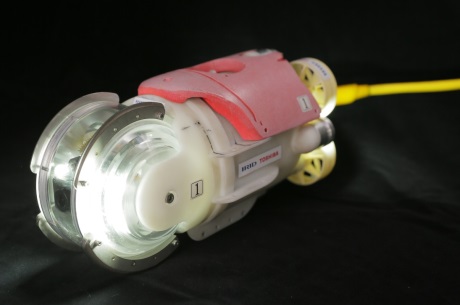An underwater robot has been developed to inspect the flooded primary containment vessel (PCV) of unit 3 at the damaged Fukushima Daiichi nuclear power plant in Japan. The robot is expected to be deployed in the coming months, following the training of operators.
 |
| The compact, submersible robot set for use in unit 3 (Image: Toshiba-IRID) |
A survey conducted by Tokyo Electric Power Company (Tepco) in October 2015 found that the PCV of unit 3 was flooded with coolant to a depth of about 6 meters. The size of any robot to be deployed for inspecting the interior of the vessel is limited by the size of the penetration hole giving access to the PVC. This hole is just 14cm in diameter.
Goro Yanase, general manager of Toshiba Corporation's nuclear energy systems and services division, said: "We have already developed remotely operated robots for inspections at Fukushima. In this case, we had to meet the specific challenges of limited access and flooding, in a highly radioactive environment."
He added, "Working with the International Research Institute for Nuclear Decommissioning (IRID), we succeeded in developing a small robot with high-level radiation resistance, and through its deployment we expect to get information that will support the advance of decommissioning."
The screw-driven submersible robot developed by Toshiba and IRID is 30cm long and has a diameter of just 13cm, enabling it to be inserted through the PCV penetration hole. Weighing about 2kg, the robot is equipped with front- and rear-facing video cameras and LED lights. It is powered and remotely controlled via wire, and is radiation resistant to about 200 Sieverts.
The robot will be used to provide video feed of any interior damage to the PCV and information on how best to retrieve fuel debris.
In February, Tepco sent a "scorpion-shaped" robot - also developed jointly by Toshiba and IRID - into the PCV of Fukushima Daiichi unit 2. About 54cm long, 9cm high and 9cm wide, and weighing about 5kg, that robot was designed to enter the unit's PCV along a pipe about 10cm in diameter. It too was remotely operated by a wired cable. Although the robot was unable to reach the part of the vessel directly under the reactor pressure vessel, the company said the information it gathered would help it determine how to decommission the unit.
The following month, Tepco carried out an investigation of the PCV of unit 1 at Fukushima Daiichi using the PMORPH robot developed by Hitachi-GE Nuclear Energy and IRID. Equipped with a dosimeter and waterproof camera, it took radiation readings and digital images at ten different measurement points within that unit's PCV.
IRID was in August 2013 to conduct research and development to improve technical standards and advice for decommissioning nuclear plants.
Hirohisa Kuwabara, general manager of IRID's R&D strategy planning department, said, "We will continue to develop technologies that contribute to the decommissioning of the plant."
Researched and written
by World Nuclear News




_18570.jpg)
_16159.jpg)
_18938.jpg)
_33584.jpg)





